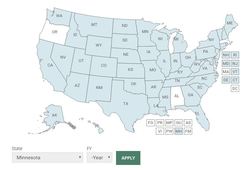|
Having trouble viewing this email? View it as a Web page.
|
|
|
|
|
|
Repay veterinary student loans with help from the USDA
 Veterinarians are needed in America's rural communities. Current veterinary school graduates accumulate an average of $135,000 in student loan debt.
The U.S. Department of Agriculture’s (USDA)
National Institute of Food and Agriculture (NIFA) offers a solution to both issues, and it awarded more
than $4.3 million to help solve the shortage. Nearly 50 veterinarians in 27 states received awards to repay a portion
of their veterinary school loans. To qualify, they simply have to serve in a geographic area where veterinary resources are insufficient. Veterinarians are critical to our nation's food safety, food
security, and health and well-being of animals and humans.
Studies indicate there are significant shortages of food animal
veterinarians in certain areas of the nation and in high-priority
specialty sectors, which require advanced training, like food safety,
epidemiology, diagnostic medicine, and public health.
New award recipients commit to practice at least three years in a
designated veterinary shortage area. Full details about the program and a map of current shortage areas are available on the NIFA website.
|
Minnesota Poultry Testing Laboratory ready and running
 The
Minnesota Poultry Testing Laboratory (MPTL) is renovated and running new diagnostic tests. The September Grand Opening marked the starting line of the lab's new capabilities. Since then, newly hired and trained technicians have been accepting and testing samples with Molecular Diagnostics, or PCR testing. Poultry producers can submit samples for testing Avian Influenza, Avian Metapneumovirus, and Newcastle Disease.
Routine serology and bacteriology testing will continue being offered in the expanded lab. Routine influenza testing is conducted daily and other tests are run weekly, based on demand.
Mycoplasma and Salmonella PCR testing will begin soon when the new equipment is calibrated and technicians are further trained. Look for an email from the MPTL when those tests become available.
The Willmar lab expansion makes it the second site in the state to offer PCR testing. The other is the Veterinary Diagnostic Lab on the University of Minnesota's St. Paul campus. Test results from either laboratory are posted on the VDL website. Submission forms and fee schedules are available online at www.vdl.umn.edu. Please feel free to call the MPTL at 320-231-5170 with questions
regarding PCR submissions.
|
Chronic Wasting Disease group seeks comments
 USDA-APHIS Veterinary Services has released the Chronic Wasting
Disease (CWD) Program Standards Working Group Summary Document for review and
comment. It summarizes the results of a 12-member working group of representatives from the farmed cervid industry and experts. The
group met in person for three days and continued discussions over a series of six
conference calls.
The objectives of the working
group were to identify changes APHIS should consider for the CWD Program
Standards and to describe additional options to consider for compliance with 9
CFR 55 and 81. Specific discussion topics included clarifying the purpose of
the program standards, certified herd surveillance and compliance requirements,
definitions, CWD susceptible species, ante-mortem testing, carcass disposal,
epidemiology investigations and reporting, indemnity prioritization, and
requirements for interstate transport of wild-caught cervids.
Read the document on the Cervid Health website.
Please submit written feedback by November 15,
2016.
|
 |
|
|
|
©2016 Minnesota Board of Animal Health | 625 Robert St N | St Paul | 55155 www.bah.state.mn.us
|
|
|